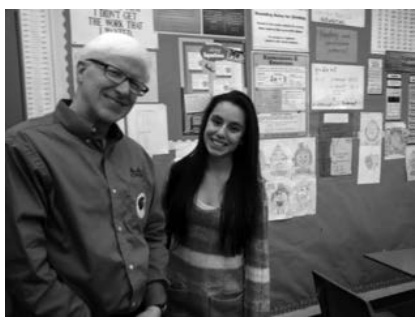Mark Cote’, CPM Project Manager
Every so often the phone rings and, instead of an insurance salesperson or a scammer calling to transfer a large sum of money into your bank account (just send him the pin and the account number), it is someone you actually want to talk to. I received such a call last fall.
“Hi Uncle Mark! It’s Angelina,” said my niece with a very upbeat and joyful tone of voice.
“Hi Angelina! Wonderful to hear from you. How are you doing?” I replied.
“I’m fine. You know what? They handed out our new books in math class today, and your name is in it! I told my teacher that you’re my uncle and she said you should come visit our class as a guest speaker!” Angelina seemed truly excited about this occurrence, but you could also hear the adolescent voice of doubt in her head wondering ‘Uh oh. Is this going to be embarrassing?’
“Wow, what a coincidence!” I replied. “And how nice of your teacher to invite me.” Having worked with adolescents for the better part of thirty years, I added, “We’ll do something fun and I promise not to be embarrassing.”
This delightful conversation happened because Angelina is currently a student at Herman Intermediate School in San Jose, CA. The Oak Grove School District is piloting the Core Connections Middle Grades Program. By happenstance, I would soon be traveling from Washington state to San Jose for a family celebration.
After exchanging several emails in December with Barbara Maguire, Angelina’s energetic and gracious teacher at Herman, and Principal Laura Meusel, a visitation date was set. We continued to talk during the next several weeks about course objectives, class progress, and possible lesson ideas. I was also contacted by Shannon Anido-Bui, the Oak Grove Educational Services Coordinator about the possibility of visiting other classes and meeting with several teachers from the other middle schools at the end of the teaching day. This sounded like a wonderful opportunity to offer additional support. Shannon gave rave reviews for the initial training provided by Gail Standiford, CPM Regional Coordinator for the San Francisco Bay Area and Teacher Leaders Gabrielle Baumgartner and Jan Carlson-Williams.

What a superb visit to Herman Intermediate! Barbara and I enjoyed the opportunity to team teach a lesson that helped the students understand the connection between proportional relationships, lines, and linear equations. We also employed several study team strategies to promote discussions and help consolidate the learning. The final bell of the day came very quickly. After bus duty, Barbara and I debriefed as teachers from the other intermediate schools in the district arrived. Over the next hour we had a stimulating discussion about grouping, pacing, and a number of other topics. As I packed up and prepared to leave, Shannon remarked, “Thank you so much for your time! I have loved learning about CPM during this pilot year!”
How did I get to help work on the textbook? I have been fortunate to participate in numerous outstanding professional development opportunities with CPM. One of the very best was assisting in the creation of the Connections Series and the Core Connections Series as a contributing author on several writing teams. For 26 years, CPM has relied on scores of classroom teachers just like you and me to make the textbooks. After responding to a request for writers and submitting several sample problems, I was asked by Senior Managing Editor Leslie Dietiker to join the team. A year of hard work lead to one of the proudest moments in my professional life, holding a copy of the finished text while reflecting on the dedication of dozens of CPM teachers who committed an enormous number of hours to the project. And now, our manual for learning mathematics was in the hands of my niece, one of ten million students who have participated in a CPM course.
I am fairly certain that Angelina was not too embarrassed to have her uncle visit school because she was willing to be in the picture. Here we are, two members of the CPM family, at zero degrees of separation!

